Join us for the return of our much loved Branch Meetings with guest speaker our very own Alex George giving a special presentation on the ‘Plant Collectors of the South West’ from the early French to present day.
Photograph: Verticordia grandis by Mark Brundrett
Join us for the return of our much loved Branch Meetings with guest speaker our very own Alex George giving a special presentation on the ‘Plant Collectors of the South West’ from the early French to present day.
2024 Committee
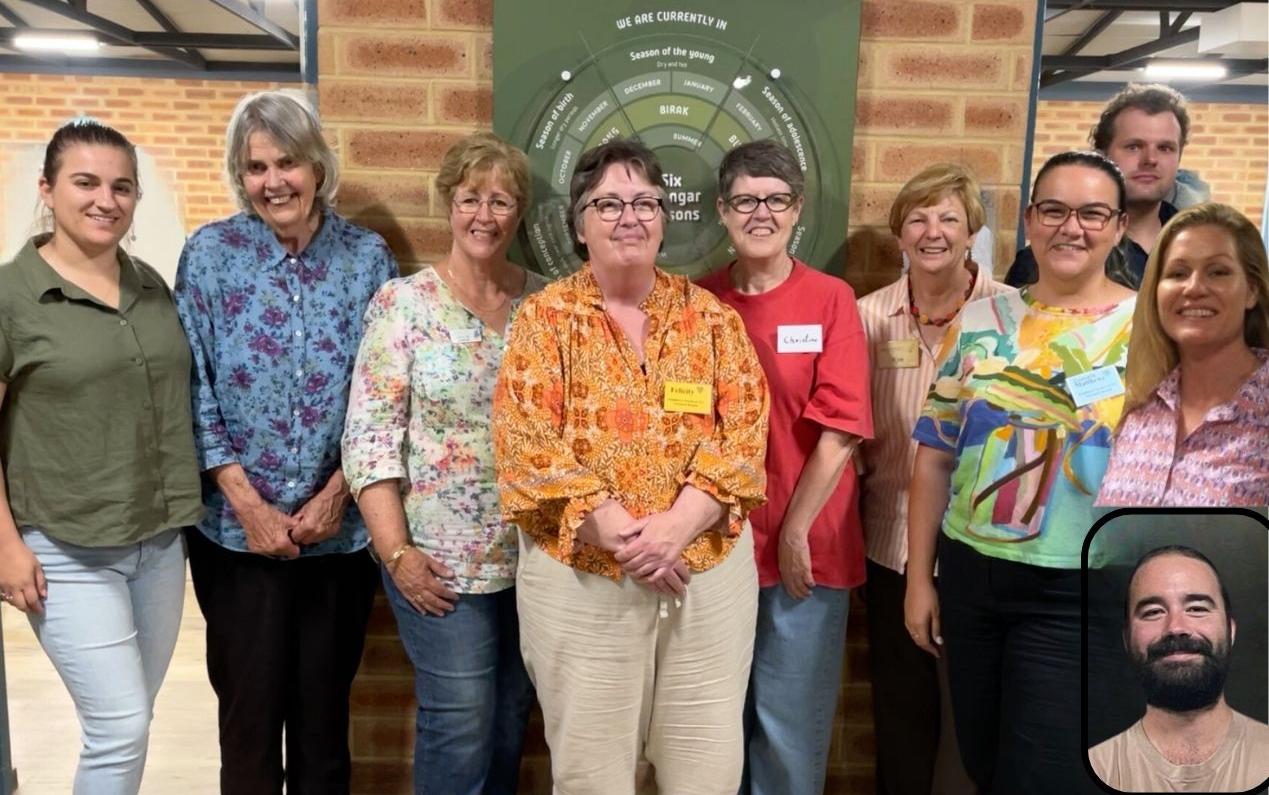
2024 Branch Committee L-R Christine Athanassiou, Diana Corbyn (Vice President), Lesleigh Curnow (Book sales), Felicity Bairstow, Christine Polmear (President), Kim Dravnieks (Secretary), Danielle Mathews, Mat Woods, Angela Hine and Michael Davies (inset – Treasurer)
President – Christine Polmear moved to WA 20 years ago and currently works in administration at Notre Dame University. Her interest in our beautiful native plants grew through exploring Western Australia and falling in love with our wildflowers.
Vice President – Diana Corbyn has been with the Murdoch Branch since year dot. Her interests are botany, ecology and bushland restoration. She currently represents the WSWA on the Rehabilitating Roe 8 Advisory Committee. Most of the committee were taught by Diana at some stage.
Secretary – Kim Dravnieks has been a branch member since returning from Europe over 30 years ago. With a background in IT, horticulture and community campaigning she has a passion for protecting our natural environment.
Treasurer – Michael Davies has a keen interest in native plants and works in a local government bushcare team.
Committee Members:
Media Coordinator: Danielle Matthews has taken on the role with our social media and newsletter production and introduced live streaming our guest speakers each month.
Felicity Bairstow is a key member of many environmental organisations and committees, including the Wetlands Conservation Society and SERCUL. Felicity played a pivotal role in the Save Beeliar Wetlands campaign over many years and continues to work towards their protection. Felicity is a past Treasurer of our branch.
Mathew Woods works as a senior Conservation officer at the company Landcare Weed control. Outside of Mat’s work, he has various hobbies like playing video games and gardening. Mat also really likes plants and is a past President of our branch.
Angela Hine – Angela has a background in teaching Conservation and Ecosystem Management, guiding walkers along the Bibbulmun Track, conducting remote terrestrial fauna surveys and bushland restoration.
She enjoys bushwalking and introducing others to the delights of our amazing native plants and has been a Murdoch Branch member since 2010.
Guest Speaker Coordinator: Christine Athanassiou – Christine is an Environmental Officer with a passion for conserving our natural ecosystems from microscopic fungi and native bees all the way to large Eucalyptus trees and native fauna. She enjoys learning about plants, their ecological function, and connections. Sharing this knowledge with others and adding value to our bushland.
We are a friendly bunch, always keen to see new people at our monthly talks and hear about new activities we could run at the Branch. Please tell us of any specialist subject or guest speaker you would like to hear from: murdoch.secretary@wildflowersocietywa.org.au
What is Arborescence? Arborescence is the term used to describe a plant as “tree-like”. And there are many plants that are arborescent , pines, eucalyptus, balga’s, palms and tree ferns to name a few. Plants like pines and eucalyptus are what fall into the “correct” definition of a tree.
To begin at basics a plant will grow by creating “primary growth” which makes the phloem and xylem that we are familiar with. A “tree” goes a step further by producing what is called secondary growth from the vascular cambium layer, although it looks more like a ring in cross section. What this means is that secondary phloem and xylem is created, thickening and widening the stem.
Other plants however also achieve arborescence without using a cambium layer. Monocots like Xanthorrhoea, Pandanus and the palm family achieve this by different methods.
1. Thick persistent leaf bases seen in Xanthorrhoea are one solution, by allowing your leaf bases to take the main support role this overcomes the need for a cambium layer.
2. Pandanus achieve arborescent status by growing prop roots to support an expanding canopy.
3. The palm family Arecaeae, the most famous arborescent monocots use a different method, they use secondary thickening. But not from a single cambium layer. Rather the parenchyma cells within individual vascular bundles do. This is called anomalous secondary growth.
Now within the ferns there are two primary methods.
1. The first is by strengthening the internal stem with hard sclerenchyma, this hardened tissue runs lengthways through the stem.
2. The second method is by the growth of special fibrous, interlocking roots called a Root Mantle. These roots can grow all up the stem and is widest at the base. An extinct tree fern species called Tempskya relied entirely upon it’s root mantle, reaching heights of 6m. This reliance on the root mantle also gave the plant a peculiar appearance (as seen above).
3. Finally ferns also use persistent leaf bases.
Now we might think that is the end of it, but wait. I found another method used by the now extinct lepidodendrids. Lepidodendrids could grow as high as 55m and have a trunk diameter of 2m. they gained arborescence by enlarging and thickening their outer bark layer.
So there you have it all of the methods (that I could find) of becoming arborescent.
References
Moran, R,C. 2004. A Natural history of Ferns, Timber Press INC. London
https://florabase.dpaw.wa.gov.au/browse/profile/22740
https://florabase.dpaw.wa.gov.au/browse/profile/22753
http://xfrog.com/product/PR18.html
Here is a list and brief description of bushland reserves I have either worked in or have visited recreationally.
1. Kings park
Kings park located near the city is a show of wildflowers from around western Australia. From the Kimberly to Albany and the inner deserts this park allows people the pleasure of seeing wildflowers from around the state. And the endangered species In those regions.
2. John forrest NP
John Forrest Np is a very large reserve of good quality jarrah forest located in Mundaring just on the Great Eastern Highway. Featuring several walk trails for varying fitness levels, including A historic railway walk, a six hour trek and last but not least a scenic wildflower walk.
3. Ellis brook reserve
Otherwise known as sixty foot falls, Ellis brook reserve is also located in the Perth hills. Here jarrah intersects with wandoo and salmon gum. Around the waterfall it becomes wet enough to allow native ferns to grow in the granite crevices
4. Wireless hill reserve
Wireless hill is a large reserve located in the middle of suburban Ardross. Featuring plenty of orchids and other wildflowers close to the very well made tracks, perfect for photo opportunities. The reserve is maintained by the very passionate Friends of Wireless Hill. So why don’t you go and help them out, enjoy wildflowers and make friends at the same time.
5. Lesmurdie falls
Very similar to Ellis brook reserve, with wandoo trees and featuring a waterfall. Lesmurdie falls also has a nice display of low shrub flowers on the higher ridges.
6. Mary street 212
Mary street 212 isn’t the actual name of the reserve in fact I don’t think it has any official name. mary street is an out of the way, not very prominent wildflower reserve located in Wanneroo . A small reserve it is actually in extremely good condition and is an excellent place for wildflower photography.
7. Kensington bushland
Kensington bushland located within walking distance of the West Australian Herbarium is an example of Banksia woodland on Perth’s Bassendean soils. Here you will see abundant stands of Banksia and a thick shrub layer.
8. Shenton park
Formerly used as a rubbish tip, Shenton park bushland is a very nice patch of remnant bushland located a few kilometres from the coast. In addition to the untouched bush areas, extensive revegetation works have been made to rehabilitate the bushland area.
You should also check out the wildflower reserve lists on the wildflower society website for maps and more information.
– Mathew Woods
The last AGM at Murdoch Branch resulted in the election of a new group of enthusiastic Murdoch Branch Committee Members. With a few changes along the way our current committee is: President: Christine Allen, Vice-President: Diana Corbyn, Secretary: Sheree Walter, Treasurer: Mathew Woods, General Committee Members: Felicity Bairstow, Gus King, Ross Young, and Eddy Wajon. Let’s introduce you to the team:
Dr Christine Allen has been a life-long plant-lover and spent her childhood exploring the second-oldest National Park in the world, the Royal National Park in NSW. The weird and wonderful diversity of plants in the southwest of WA drew her to Perth where she completed a PhD at UWA with DPaW on threatened flora in the Stirling Range National Park. Christine is now an active advocate for conservation and sustainability. Favourite plant: Banksia coccinea.
Diana Corbyn has served as Branch President through three terms, has been a Vice President and a committee member throughout the life of the branch. Since she became a lecturer at South Metropolitan TAFE’s Murdoch Campus in 1991 she continually enthuses her love and knowledge of the local flora in hearts and minds of the students she teaches. In 1998 she initiated the wildflower walks and has continued to this day. Come on out this year and meet Diana at Wireless Hill, Orelia or Samson Park.
Sheree Walters joined Murdoch committee for the first time, few weeks after our AGM (Welcome!), and she took bravely on a responsible role of secretary. Sheree grew up in the wheatbelt region of Western Australia with a passion for the environment and natural landscapes. After completing a Bachelor degree in Environmental Science in 2014, Sheree has recently returned to Curtin University to undertake a PhD in restoration genetics of native flora. She is particularly interested in landscape ecology and the importance of biodiversity – including plants, animals, insects and fungi – in both natural and restored landscapes.
Mathew Woods is our fantastic treasurer. Mat works in the Bushland’s and Wetland’s of Perth. Mat has a Love of all plant life but especially WA natives. He is particularly fascinated by the food plants and prehistoric flora. He was exposed to the native plants very early while camping in the Jarrah forest and surrounding regions and could not get enough. This fascination led him to study Conservation and Land Management at the Challenger Institute of Technology. In his spare time Mat enjoys practicing traditional bushman skills.
Felicity Bairstow (ex McGeorge) calls herself a life long nature nerd from country WA. She has spent the last 20 or so years working to conserve bushland and wetlands south of the Swan river here in Perth. A lot of that time went into the long campaign to protect the North Lake Reserve from Roe Highway Stage 8. She is now a co-convenor of the Community Wildlife Corridor group which has the vision of transforming the now partially cleared road reserve into a wildlife corridor and trail for people to enjoy and learn about the amazing plants, animals and culture of this area. Felicity served on the Murdoch committee many years ago and is very pleased to be back on Committee and dealing with much more pleasant aspects of plant conservation.
Ross Young is fresh out of uni, having graduated from Curtin University in 2014 with a Bachelor of Science in Environmental Biology. Don’t let that fool you, though – he’s longer in the tooth than you think, as uni followed a 27-year jaunt with Commonwealth Bank (and an accounting degree). Ross has a keen interest in plant ecology (and birds) and Western Australian plants (and birds), in particular – and has always been interested in the natural world around him. As a kid, he learnt (from his Mum) the pleasure to be had from being able to recognise (and name) the plants (and birds) in the garden (which, even then, included native plants). Banksias are probably his favourite plants (especially Banksia coccinea and Banksia ilicifolia) but, if pressed, he’ll still admit to a lingering fondness for roses.
Dr Eddy Wajon loves nature – whether it be chemical, botanical or zoological, he loves beauty in all its forms. He’s been called a disrupter – challenging the status quo, thinking outside the box, trying to be different, and generally annoying those in power and supposed leadership positions. However, he tries to be creative, inclusive, contributory and a force for positive change.
Angus (Gus) King, like Eddy, loves the beauty and magic of nature, especially our native trees. Other than recognising their beauty and threatened status he knows little about native plants but can still actively contribute to preserving them for future generations. He originally studied geology but more by accident than design had a career in IT. His real passion is renewable energy and even though retired he probably still spends too much time on his computer helping to bring about its adoption rather than learning those plant names.
Come and say Hi!
LIKE US and See more updates on our MURDOCH BRANCH FACEBOOK PAGE.
The Murdoch Branch of WSWA held its annual two-day field trip on 13-14 August 2016.
The excursion was organized by Ben Sims – Vice-President of Murdoch Mob. On the first day the group visited several roadside reserves including Wambyn Nature Reserve and St Ronan’s Reserve. A great diversity of plants was recorded, including several species of fairy orchids (Caladenia spp.), Mirbelias (Mirbelia floribunda on a photo above), Hakeas, sundews (Drosera spp.) and acacias, to name a few.
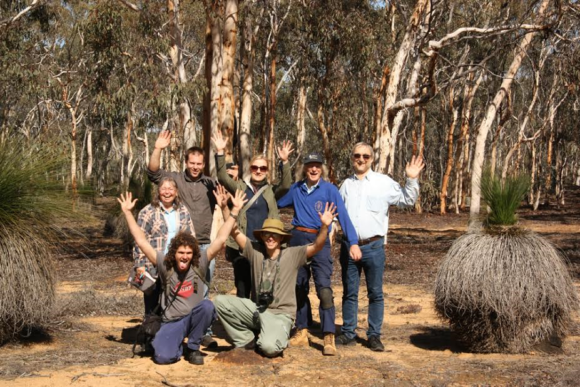
Continue reading “Murdoch Branches Out – 2016 Excursion to York WA.”
The student prizes are one of many ways we as a society try to bridge the inter-generational gap. And the older folks have a lot to share, believe me!
Perth Branch is supporting UWA students; Northern Branch is looking at ECU while Murdoch Branch is obviously looking for the best students around its own bush that is Murdoch University and TAFE Challenger.
Last two years Murdoch Branch had a great honour to award four outstanding people. Pawel – our (tall) president of the last two years (2015-2016) is very happy to hand over the awards to:
1. Merryn – the best student in “Plant Diversity” in 2015:
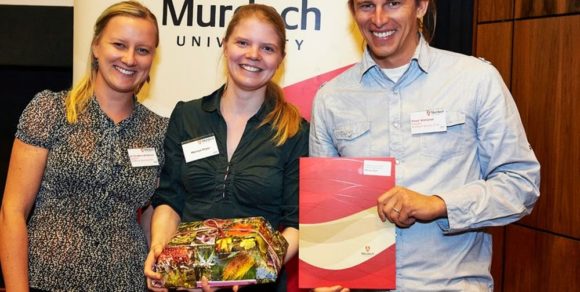
Continue reading “Be Awarded, Be Connected – Student Prize Winners.”
The Wildflower Society of Western Australia Inc. (WSWA) was established in 1958 to promote the value of our natural bushland. The Society does this through regular meetings and excursions, native plant sales, bushland plant surveys, book sales, donations, and attendance at relevant events and much more …
Murdoch Branch introduced an additional function to numerous tasks our vibrant community has committed to. We have embarked on cleaning up the Roe 8 Reserve. As part of the national Clean Up Australia Day, on Sunday March 6, 2016, The Murdoch Branch of the Wildflower Society joined forces with Cockburn Council, Rethink the Link Alliance, and the Save Beeliar Wetlands community to clean up the beautiful remnant bushland that is standing proud against the ill-conceived idea of pushing a highway through to soon-out-of-capacity Fremantle Port.
It was the 27th celebration of Clean Up Australia Day an idea initiated by Ian Kiernan that in 1993 gained the support of the United Nations Environment Programme (UNEP) that turned into Clean Up the World Day.
The event went far beyond what participants expected as community neighbours jumped out on the street to offer a helping hand and served chilled drinks in the heat to the hardworking volunteers.
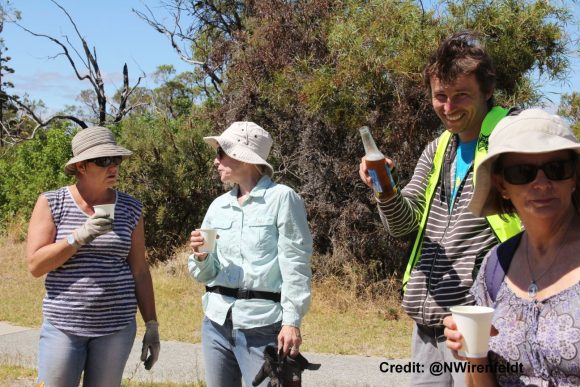
More than fifty members had shown their interest on Facebook to take part in the event. Fifteen people gathered on the ground to clean up the Roe 8 bushland. The youngest, aged 5 and 7, received Certificates of Participation as recognition by Clean Up Australia, as they did persevere till the end of the event with enthusiasm.
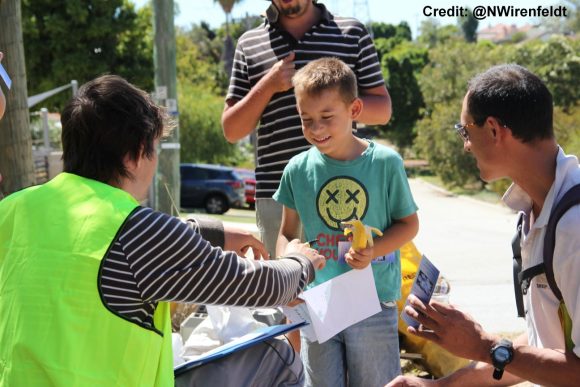
Pawel Waryszak, Wildflower Society of WA Murdoch Branch President and the Event Convener, explained what Clean Up Australia Day meant to him: “Clean-Up Australia creates a great community feel. Today I met so many of my neighbours who I would normally not have a chance to talk to”.
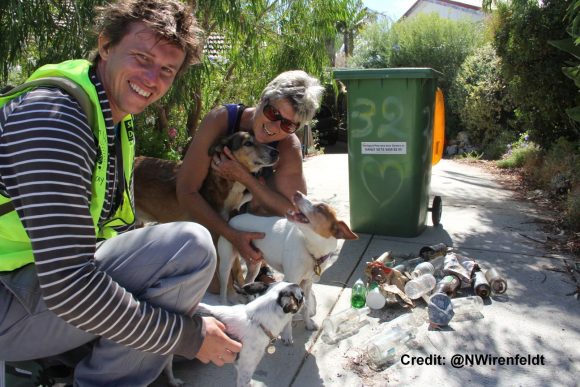
“I definitely underestimated the scale of littering in our local bushland. We managed to cover only a quarter of what we planned to do in the two hours allocated to the clean-up”, Pawel concluded.
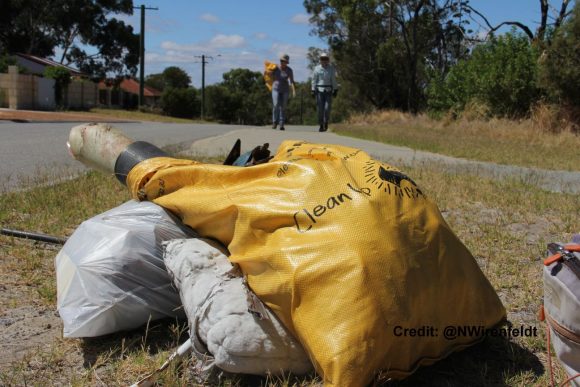
One of the volunteers, Robin Scott, student at Murdoch University and environmentalist, added enthusiastically: “I came along as I know that dumping off rubbish is a big issue when it comes to the management of bushland in Perth. Clean Up Australia Day lived up to my expectations as I was expecting there to be a lot of rubbish involved”.
Nicole Carey, PhD Candidate in Wetlands Conservation at Murdoch University, who also came to give us a hand said: “I liked that it was an easy way to care for the local environment, while contributing to a national event. A truly fun, social morning”.
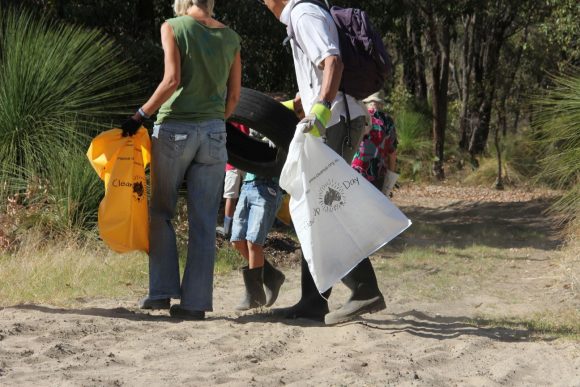
Pawel calls for a bigger turnout next year with more community involvement that is much needed in order to conserve our beloved bushland.
The AGM in December 2015 resulted in the election of a new group of enthusiastic Murdoch Branch Committee Members: Vice-President: Ben Sims, Secretary: Christine Allen, Treasurer: Mathew Woods, General Committee Members: Christina Birnbaum, Eddy Wajon, Diana Corbyn, Gus King, Neil Goldsborough, Ross Young, and Pawel Waryszak accepted the honour of being re-elected for the second time as Branch President. Let me introduce you to the team:
Come and say Hi. See more updates on our MURDOCH BRANCH FACEBOOK PAGE.
Lorem ipsum dolor sit amet, consectetur adipiscing elit. Sed sed lacus et neque consequat euismod at ac odio. Vestibulum viverra urna orci, elementum dignissim sapien interdum vestibulum.
Read moreLorem ipsum dolor sit amet, consectetur adipiscing elit. Sed sed lacus et neque consequat euismod at ac odio. Vestibulum viverra urna orci, elementum dignissim sapien interdum vestibulum.
Read moreLorem ipsum dolor sit amet, consectetur adipiscing elit. Sed sed lacus et neque consequat euismod at ac odio. Vestibulum viverra urna orci, elementum dignissim sapien interdum vestibulum.
Read moreLorem ipsum dolor sit amet, consectetur adipiscing elit. Sed sed lacus et neque consequat euismod at ac odio. Vestibulum viverra urna orci, elementum dignissim sapien interdum vestibulum.
Read moreLorem ipsum dolor sit amet, consectetur adipiscing elit. Sed sed lacus et neque consequat euismod at ac odio. Vestibulum viverra urna orci, elementum dignissim sapien interdum vestibulum.
Read moreLorem ipsum dolor sit amet, consectetur adipiscing elit. Sed sed lacus et neque consequat euismod at ac odio. Vestibulum viverra urna orci, elementum dignissim sapien interdum vestibulum.
Read moreComing Events
23 April @ 7:30 pm
Instead of the monthly Tuesday night meeting, an excursion to Mt Flora Regional Museum and surrounding limestone heath bushland will […]
Read more24 April @ 10:00 am
A guided look at the Limestone Heath bushland on Mt Flora with David Pike and a look through Mt Flora […]
Read more26 April @ 7:30 pm
For years Bronwen has served on the Committee, been a principal organiser of the Plant Survey programme as well as […]
Read more27 April @ 8:00 am
Join David Pike for a 90 minute guided walk through the Star Swamp Bushland, looking at flora, insects and wildlife. […]
Read more27 April @ 9:00 am
Come along to the annual Autumn Plant Sale at Northern Suburbs branch nursery at Landsdale Farm. Hundreds of species available […]
Read more1 May @ 9:00 am
This group meets fortnightly to prepare seeds for the propagation of native plants. The group maintains an extensive seed bank […]
Read moreThe Wildflower Society uses its independent technical knowledge of WA’s wildflowers to help you better know, grow, enjoy and conserve the wildflowers of Western Australia.
We are committed to providing help to the following…